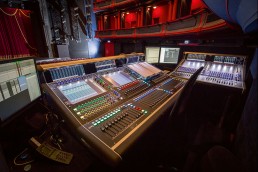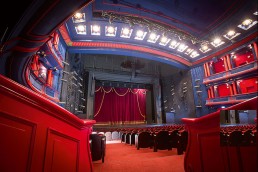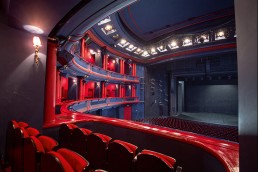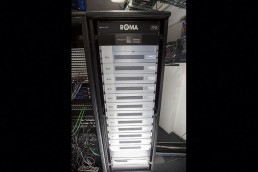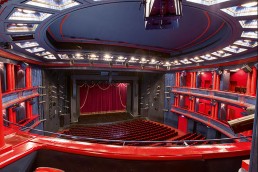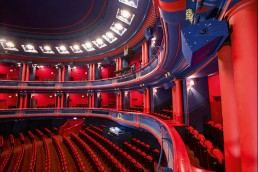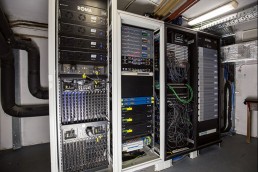This website uses cookies so that we can provide you with the best user experience possible. Cookie information is stored in your browser and performs functions such as recognising you when you return to our website and helping our team to understand which sections of the website you find most interesting and useful.
Teatr Muzyczny Roma
ProjectTeatr Muzyczny RomaLocationWarsawManufacturers Meyer Sound, DiGiCo, Allen & Heath, Shure, ETC, Clay Paky, RobeArchitectStefan SzyllerInstallerAirpol Sound & LightSubmitted by Airpol Sound & Light
Opened in 1935, Teatr Muzyczny Roma was one of the few buildings in Warsaw that survived the war. Consequently, post war it was the location for the State National Council to hold its meetings. The council was a political body designed by the USSR, which served as a self-appointed Polish Parliament. Three years later in 1948, the Warsaw Philharmonic Opera made Teatr Muzyczny Roma its temporary home – because its original home was destroyed in the war – and it remained there until 1965. The Warsaw Operetta took over residency that same year and stayed right through until 1994, when the name of the building was officially changed to Teatr Muzyczny Roma, and therefore the show programme for the space changed, too, sparking the beginning of musical theatre at Teatr Muzyczny Roma.
With a strong reputation to uphold, it won’t come as any surprise that the theatre has undergone a continuous upgrade of audiovisual packages. However, there has been a significant audio upgrade of late that pushes the boundaries of theatres in general, but definitely within Poland – there is currently nothing else like Teatr Muzyczny Roma from a technology perspective.
With the old PA, the subwoofers had been flown behind the line arrays, but Krzysztof for Airpol Sound & Light’s design didn’t match the old system, as he was concerned about interference. Instead he designed and sourced a specially constructed frame for the four subwoofers to sit within a two-by-two configuration, which was then ceiling mounted in just 22 hours.
“I also designed a new setup for infills, installing them on the porter wall, as they could no longer be installed on the columns, due to decreasing the proscenium. The two eight UPA1P infills work well in their new positions because they move the sound towards the front of the audience. Of course, we also have front fills in the form of UPM1Ps, which are built into the front of the stage,” Krzysztof continued.
Eight Meyer Sound MINA cabinets were purchased for a central cluster. Shortly after installation, Krzysztof spoke to the mixing engineer. He continued: “He was putting the vocals through the centre channel and the music through the L-R sides, which was a much better solution because it allowed more headroom in the loudspeakers in all three arrays. However, there was a big difference in SPLs due to there being 13 boxes in the L-R hangs and only eight in the centre. I worked with the mixing engineer to tune the system, lower the levels of the side hangs to match the centre hang to create the desired output.
“For FOH we have the SD7T with an EX007 console expander, the latter stems from the previous mixing setup and the mixing engineers being used to having a certain amount of faders, because in order to control 40 wireless mics on one layer, the engineers wanted as much access as possible, for occasions when there is a fast change, for example. I added an expander, on which they have the orchestra in the groups that allows the song list to be on the main console, as well as some effects, surrounds and media servers. We decided on another SD7T for monitors, again so we had more redundancy, if one engine fails, the other can take over.” In addition to the consoles there are two Waves SoundGrid servers per console – two Extreme servers for FOH and two One servers for the monitor console, one on each engine – and there are ProShow plugin bundles, too.
“The console is the heart of everything and controls everything – this was one of my principles. Some productions that come through the theatre bring their own console for monitors, but then when they see the DiGiCo setup they decide to use the full in-house system. I’d say 60%-70% of the productions use the installed system.”
The theatre is also home to four DiGiCo SD Racks – one for radio microphones, two in the rack room connected directly to the orchestra pit and the final one is a spare, used for external productions. “Because we don’t always use all the rack space, we also have connections for the media server, the light signals, and the Meyer Sound D-Mitri platform. For this we added some Optocore X6R-FX devices, which gives us more inputs and outputs to and from the system,” Krzysztof furthered. “I also added an Optocore Route66 AutoRoute, which opens the Optocore loop automatically when a device is connected. Likewise when you disconnect, it closes the loop. With the Route66, you can change the topology of a loop installation, to a star topology installation. I am very impressed with this device, all you have to do is turn it on and forget.”
The surrounds are based on Meyer Sound’s D-Mitri platform and comprise three rows of loudspeakers using a combination of UPM1Ps, UPJ1Ps and UPQ1Ps. The 3D audio effect covers the entire main audience, as well as the VIP booths – the additional booths will be added to the system at a later date.
The lowest row of surrounds are hung underneath the balcony to avoid interferences with sightlines and aesthetics, and the cabinets have been colour matched in navy to complement the décor. The middle row are mounted at booth height, but are mounted on the columns in between the booths, again, for aesthetic reasons.
Teatr Muzyczny Roma has been making use of Shure’s ULX-D system since it was first introduced. Polsound’s Pawel picks the story up again: “The ULX-D systems were the first digital systems that had a lot of channels that could go into a very small space in the RF spectrum. The Shure ULX-D systems can have 22 channels going into one 8MHz TV channel, and here we have 60 channels – 40 on the main stage and 20 on the small stage. For control, management and monitoring of the wireless systems, the theatre has a WaveTool Platinum software package. If a microphone has a problem, it can be found quickly using the WaveTool.”
“When we look at the Meyer Sound PA and the DiGiCo consoles, this is a system that can produce a very wide dynamic range, which brings the audio experience closer to reality. In this case the sources also need to offer the same range. The ULX-D systems have over 120dB of dynamic range, which means that these systems have a nearly none existent noise floor. This has created, a sort of paradox problem because all of a sudden the quality of the microphones is immediately visible. In the past, analogue systems have had an inherent hiss sound, and the self noise of the microphone generally got masked by it. But now, the system is so clear, you can hear absolutely everything! The issue of high quality, low noise, wide dynamic range microphones for theatres has emerged and Shure is addressing that”.
The theatre has also been making use of Visual Act Wagon and Spider camera systems, which are essentially moving platforms housing LED screens to provide scenery and scene changes. They are wireless and individually controllable, making for a very flexible visual set-up.
Content for the LED screens is provided by two disguise 4x4pro media servers – one for redundancy – and tracking is carried out through a BlackTrax system that can also be connected to the D-Mitri platform. Three Christie 4K30 projectors are also at home in the theatre. This setup, along with anything else technology wise is under the leadership of Technical Manager, Anna Was. She said: “I love technology and I want to make big improvements in the theatre all the time. I love similar people who share a love of technology and deliver to the end user.”
Anna has an eye for detail, especially given that she is also a costume designer in her spare time, and she assumes that role for many of the theatre shows, too. In addition to her visual equipment, Lighting Design, Marc Heinz also specified a number of moving heads and theatrical lighting fixtures for Anna’s disposal. The mostly LED line-up includes more than 40 ETC Source Four profiles, almost 100 Clay Paky moving heads, 49 intelligent lights from Robe – Spiiders and T1 Profiles – and four Robert Juliat Victor followspots. Teatr Muzyczny Roma is also the first theatre in Poland to invest in four Robe RoboSpots for remotely controlled follow spots. All of these are controlled via a MA Lighting grandMA2 Light console – and of course there is a second one for redundancy.
